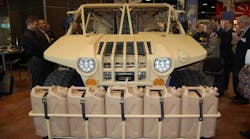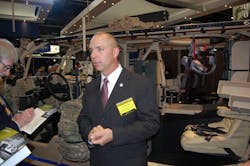So I got a call from my good friend and neighbor Frank Sturek the other day to tell me about a new military vehicle his company – Northrop Grumman Corp. (NGC) – would be unveiling at the Association of the United States Army (AUSA) 2012 annual meeting and exposition in Washington D.C. this week.
I thought to myself, sure, getting a chance to kick the tires (as it were) on this new Medium Assault Vehicle – Light (which is quickly shortened to “MAV-L” in military circles) would offer an opportunity to view a very different kind of “truck” up close and in living color; one designed to survive in environment far more dangerous than what freight haulers experience.
Yet it’s HOW this vehicle came to be – rather than the final product itself – that is almost the more interesting part of the MAV-L’s story (at least from where I sit), because the military experts at NGC chose a very unusual design partner to create it: motorsport engineering firm Pratt & Miller.
[To view more photos of the MAV-L, click here.]
Sturek told me that NGC not only wanted to start with “clean sheet of paper” to design the MAV-L but also to apply extreme vehicle engineering expertise from outside the military as well: gaining a fresh perspective on how to handle the often violent forces military vehicles are subjected to (explosions, machine gun fire … need we go on?) in their line of work.
Jim Miller – the president of Pratt & Miller and one of its co-founders – explained to me that his company operates on a very simple philosophy: design, develop, build, race, and win.
Originally, he told me NGC came to his firm solely to find ways of improving vehicle occupant safety. “We crash cars into walls at speeds of 150 mph or greater, but the driver gets out and walks away,” he told me. “They wanted to learn how we did that.”
Very quickly, however, that design conversation broadened to encompass many other vehicle parameters: maneuverability, ride and handling, reparability, and (of course) durability.
Those were all facets of the request for proposal (RFP) released by the Department of Defense (DOD) back in April this year in an effort to provide a safer yet faster and more durable vehicle for “special operations” forces, such as the Green Berets, U.S. Army Rangers, as well as long range reconnaissance patrol missions conducted by regular Army units.“The DOD wanted an affordable vehicle that not only met the operational requirements of those soldiers, but one that also proved fast, flexible, and above all reliable,” noted Tom Vice, NGC’s corporate vice president and president of its Northrop Grumman Technical Services division. “Combining our defense expertise with racing expertise marks what we believe is unique advancement in military ground vehicle technology.”
[NGC also brought in BAE Systems into the project to help on the production end of things, tapping the expertise of BAE’s factory in Sealy, TX, to maintain the quality of the MAV-L design if and when it gets the green light from the DOD for mass production.]
Pratt & Miller’s Miller pointed out that his firm is no stranger to military work: indeed, they’ve done defense work for the last 10 years. But this is really the first time they’ve really brought their racing experience to bear on a military project – with some interesting results.
For starters, the MAV-L came into being in just 12 weeks – not the years and years often required to design a new vehicle for military operations – marrying the latest cutting-edge computer design programs with decades of hard-won “old school” battlefield and race track insights.“In the racing world, we like to say that when the green flag drops, you must be ready,” Miller told me. “So while we use the latest in computer simulation, CFD [computational fluid dynamics, for aerodynamic analysis], and materials science, we’ve also got to be able to not only build it fast but repair it fast too.”
That meant putting the MAV-L prototype out in the racing shop where Pratt & Miller’s racing veterans gave it a “real world” once over. “These guys can tell immediately if bolt connections will hold up under extreme conditions, or whether a fan belt location means it’ll take 30 minutes to replace … or five hours. And you can’t spend five hours replacing a fan belt, in racing or in combat.”
From where NGC’s Sturek sits, though, there are even bigger benefits from injecting motorsport expertise into the MAV-L design – especially drawn from his 25 years spent in the U.S. Army, with time spent under fire in Afghanistan and Iraq.For starters, the high performance ride – especially off road – of the MAV-L means all the bouncing and banging around troopers typically suffer in their tough but rigid transports is eliminated, he said. That way, they don’t arrive at the battlefield already worn out and sore at the very moment when bulletsand rocket propelled grenades are flying.
The vehicle is also built to comfortably accommodate fully-loaded soldiers wearing their body armor, ammo, and weapons. “You’ve got no idea how all that gear can cramp you up in a typical military vehicle,” Sturek (seen above at right) told me.
They also get that comfort without sacrificing speed, as the MAV-L can go 60 mph off-road and 80 mph on paved highways. And speed, Sturek reiterated, often means the difference between life and death in a combat zone.
All in all it’s a very neat vehicle, the MAV-L, all the more because it results from an unusual mix of military and motorsport expertise. Now all I must do is figure out how to test drive one of these machines!






